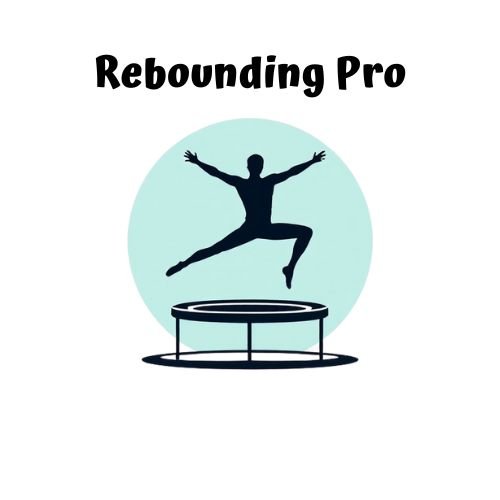Rebounding on a mini trampoline is 68% more effective than jogging, burning up to 12.4 calories per minute with 80% less impact on your joints. You’ll engage multiple muscle groups simultaneously while the G-force increases your effective body weight, enhancing calorie burn. Just 15 minutes daily can create a 820-calorie deficit over ten days. Plus, the afterburn effect keeps your metabolism elevated for hours after you’ve finished bouncing your way to better health.
The Unmatched Calorie-Burning Power of Rebounding

Four key factors make rebounding a calorie-burning powerhouse that outperforms traditional exercises.
While running burns 8.5 calories per minute, rebounding can torch up to 12.4 calories per minute, making it 68% more effective than jogging at similar speeds according to NASA research.
The secret lies in the G-force created during each bounce. This temporarily increases your effective body weight, forcing your muscles to work harder during both deceleration and acceleration phases. Quality rebounders maximize this effect.
Your metabolic rate stays elevated hours after your workout thanks to the afterburn effect, continuing to burn calories while you rest. This exercise brings joy and excitement to your fitness routine while delivering impressive results.
For ideal results, aim for 20-30 minute sessions 3-5 times weekly. Just 15 minutes daily can help you shed extra 820 calories over ten days.
How Trampoline Jumping Activates Multiple Muscle Groups
Every bounce on a trampoline engages your entire body in a synchronized symphony of muscle activation.
Your lower body does the heavy lifting—hamstrings and glutes power your hip extension, quadriceps drive knee straightening, while calf muscles provide the spring in your ankles.
The powerhouse trio—hamstrings, quads, and calves—transforms each bounce into a complete lower-body workout that builds functional strength with every jump.
Meanwhile, your core muscles—abs, lower back, and pelvic floor—continuously work to maintain balance and posture during both flight and landing. This provides effective, low-impact strengthening that traditional core exercises can’t match. Trampoline training also strengthens pelvic floor muscles, supporting bladder control and overall core stability.
Your upper body isn’t just along for the ride. Arm, shoulder, and back muscles actively stabilize your movements, especially when you incorporate deliberate arm motions.
Even small stabilizing muscles around your joints activate to control balance on the unstable surface.
Bouncing Your Way to Better Metabolism

You’ll continue burning calories long after your trampoline session ends through the caloric afterburn effect, where your metabolism remains elevated for hours post-exercise.
Regular trampolining helps build lean body mass, which contributes significantly to your overall metabolic efficiency.
To maximize this metabolic boost, focus on maintaining your heart rate in fat-burning jump zones between 70-85% of your maximum heart rate.
Your body becomes a more efficient calorie-burning machine with consistent rebounding, as it increases mitochondrial production and enhances your resting metabolic rate.
Caloric Afterburn Effect
While many focus solely on calories burned during exercise, jumping activities offer a hidden metabolic advantage through the caloric afterburn effect. Known as EPOC (Excess Post-Exercise Oxygen Consumption), this phenomenon keeps your body burning calories long after you’ve stopped jumping.
| Exercise Type | EPOC Duration | Calorie Boost |
|---|---|---|
| Jump Rope HIIT | 24-48 hours | 15-20% |
| Steady Jumping | 2-6 hours | 6-10% |
| Plyometric Circuits | 12-24 hours | 10-15% |
The higher intensity of jumping exercises creates significant oxygen debt, forcing your body to work overtime during recovery. Your metabolism remains elevated as your system repairs muscles, replenishes energy stores, and restores hormonal balance. By incorporating interval-style jumping workouts, you’ll maximize this afterburn effect for enhanced weight loss results. The afterburn effect is comparable to a car engine cooling after being turned off, with your body continuing to consume energy during the recovery phase.
Fat-Burning Jump Zones
The concept of “fat-burning zones” represents one of the most misunderstood aspects of weight loss exercise.
While traditional theories suggest staying at 70-80% of your maximum heart rate for ideal fat burning, jumping exercises can actually amplify these effects through their variable intensity.
Your body’s fat oxidation doesn’t follow a one-size-fits-all formula. Instead, consider these jumping-specific approaches:
- Low-intensity bouncing (like light rope skipping) for longer durations utilizes more fat as immediate fuel.
- Medium-intensity jumping jacks improve sustained fat metabolism.
- High-intensity box jumps maximize post-workout caloric burn. These intense jumps create a significant afterburn effect that continues to burn calories even hours after your workout ends.
- Interval jump training combines different intensities to target various metabolic pathways.
Low-Impact, High-Results: Why Rebounding Spares Your Joints
Your joints will thank you for choosing rebounding as your weight loss exercise since the trampoline mat absorbs more than 80% of impact forces.
You’ll experience the joint-friendly bounce benefits that make this low-impact workout ideal even if you have existing joint issues or are recovering from injuries.
The cushioned landing advantage means you can pursue intense cardio without the wear and tear typically associated with high-impact activities like running. Minitrampoline exercises are recognized as a low-impact alternative for physical activity while still providing significant cardiovascular benefits.
Joint-Friendly Bounce Benefits
As exercisers search for effective weight loss methods that won’t damage their bodies, rebounding emerges as an exceptional solution. The mini-trampoline absorbs up to 80% of impact force compared to pavement running, making it ideal for protecting your joints while burning calories.
When you bounce, you’ll experience:
- Enhanced synovial fluid circulation that lubricates joints, reducing stiffness and improving mobility
- Strengthened muscles around joints that improve stability and reduce pressure on knees, hips, and spine
- Improved balance and coordination that prevent falls and associated joint injuries
- Increased bone density without harmful impact, benefiting long-term skeletal health
This joint-friendly approach allows you to exercise longer and more frequently without aggravating existing conditions like arthritis, making weight loss goals more achievable. With the patented T-bar available from Boogie Bounce, you can experience added stability and confidence during your rebounding sessions.
Cushioned Landing Advantage
Three remarkable technologies make rebounding a joint-saving exercise phenomenon. Mini trampolines absorb an impressive 7/8ths of skeletal shock that would normally impact your joints on hard surfaces.
The spring or bungee systems actively reduce landing forces while providing elastic rebound that lessens compression stress on your spinal discs and knees.
You’ll experience 68% greater efficiency than jogging for the same benefits, according to NASA research. This means your 10-minute rebounding session equals 30 minutes of running—without the pavement-pounding damage.
Your body avoids the vertical ground reaction forces that often lead to shin splints and joint pain. Rebounding provides a low-impact alternative for effective cardiovascular exercise while being gentle on your joints.
For rehabilitation or those with existing injuries, you’ll find rebounding offers controlled motion that strengthens connective tissues gradually while promoting spinal health through improved lymphatic circulation.
The Science Behind Mini Trampoline Weight Loss Success

Understanding the science behind mini trampoline exercise reveals why it’s such an effective weight loss method. Rebounding creates a unique physiological response that conventional workouts can’t match.
The science of rebounding unlocks a weight loss potential that traditional exercise simply cannot deliver.
- Caloric Burn: You’ll burn up to 700 calories per session while your body experiences 80% less impact than running, protecting your joints while melting fat.
- Metabolic Boost: Studies show mini trampolines improve body composition by decreasing fat mass while increasing lean muscle tissue. A 2018 study confirmed that participants experienced decreased waist circumferences after consistent trampolining routines.
- Lymphatic Circulation: When you bounce, you stimulate lymphatic flow, helping flush toxins that can impede weight loss efforts.
- Cardiovascular Efficiency: Your heart rate increases similarly to running, but with less perceived exertion, meaning you can sustain the fat-burning zone longer.
Consistency Is Key: Building a Sustainable Rebounding Routine
While the science behind rebounding offers compelling reasons to start, your long-term weight loss success hinges on consistency. Begin with 5-10 minute sessions if you’re new, gradually building to 20-30 minutes three to five times weekly. This progression helps your body adapt safely while developing the neuromuscular coordination essential for effective rebounding. Creating a proper calorie deficit through regular rebounding sessions combined with mindful eating will maximize your weight loss results.
| Time Frame | Beginner Approach | Goal Setting |
|---|---|---|
| Week 1-2 | 5-10 min sessions with support rail | Focus on balance and basic bounces |
| Week 3-4 | 15-20 min sessions, varied movements | Introduce intervals and increase tempo |
| Month 2+ | 20-30 min full workouts | Combine with strength training for metabolic boost |
Monitor your form constantly and listen to your body’s signals. As you progress, you’ll notice improved joint stability, increased energy, and steady weight loss results.
Pairing Your Trampoline Workouts With Smart Nutrition Choices
Your rebounding efforts can only take you so far without proper nutritional support backing them up. To maximize your trampoline workout results, you’ll need to create a caloric deficit while maintaining proper nutrition for energy and recovery.
Rebounding success demands nutritional discipline—create a deficit while fueling your body for performance and healing.
For effective weight loss while rebounding, follow these nutrition strategies:
- Reduce daily caloric intake by 500-1000 calories while focusing on lean proteins, high-fiber whole grains, and plenty of vegetables.
- Practice portion control with smaller, more frequent meals to manage hunger and prevent overeating.
- Stay hydrated by drinking water before, during, and after your trampoline sessions to support metabolism.
- Plan nutrient-dense meals in advance to avoid impulsive high-calorie food choices when hungry.
Remember that even with enjoyable trampoline exercises, achieving sustainable weight loss requires consistent lifestyle adjustments that incorporate both regular physical activity and mindful eating habits.
Frequently Asked Questions
Can Jumping Rope Provide the Same Benefits as Trampoline Rebounding?
Jump rope provides higher calorie burn and bone density benefits than rebounding, but it’s harder on your joints. You’ll get cardiovascular benefits from both, though rebounding better supports your lymphatic system and causes fewer injuries.
How Quickly Can I Expect to See Weight Loss Results?
You’ll likely notice improved endurance within 1-2 weeks, and visible weight loss after 3-4 weeks of consistent jumping. For significant results, commit to 6-12 weeks while maintaining proper nutrition and regular sessions.
Is Rebounding Safe for Seniors and People With Balance Issues?
Yes, rebounding is generally safe for seniors and those with balance issues. You’ll benefit from its low-impact nature, and can use stability bars for support. Start slowly and consult your doctor before beginning.
How Does Rebounding Compare to Traditional Cardio for Fat Burning?
Rebounding burns calories similarly to traditional cardio (around 230-400 calories/30 min), but it’s gentler on your joints. You’ll engage more muscles simultaneously and enjoy better workout adherence due to its fun, low-impact nature.
Can Rebounding Help Reduce Cellulite and Improve Skin Appearance?
Yes, rebounding can help reduce cellulite and improve your skin. It stimulates lymphatic flow, burns fat, increases circulation, and tones muscles—all working together to smooth skin texture and diminish cellulite’s appearance.
In Summary
You’ve discovered a fitness secret that’s both fun and effective. By making rebounding part of your regular routine, you’re not just burning calories—you’re strengthening muscles, boosting metabolism, and protecting your joints. Combine your trampoline sessions with smart eating habits, and you’ll see lasting results. So keep bouncing your way to a healthier weight—your body will thank you for the joyful journey.





Leave a Reply